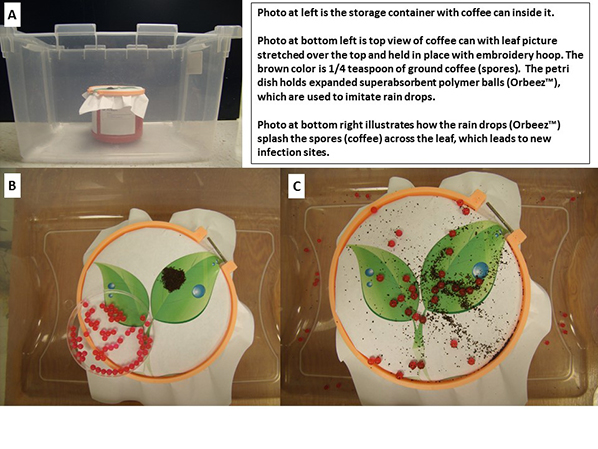Abstract
Just like humans, plants are susceptible to diseases caused by microorganisms, including (from smallest to largest in size) viroids, viruses, phytoplasmas, bacteria and fungi. Students are repeatedly told to cough into their arm or tissue to prevent spread of human diseases such as flu and colds, but they are seldom told how plant diseases are spread. This demonstration illustrates one method of plant disease spread, water splashing of fungal spores or bacterial cells. Living plants and pathogens are not required, and neither is water. Instead, coffee grounds are substituted for spores or cells and polymer balls are used for water drops. Pathogen spread is the result of velocity (magnitude and direction) of each polymer ball at the point of impact and the amount of coffee grounds (spores or cells) it hits.
It is suggested that prior to the demonstration, a color illustration of a leaf spot or fruit spot disease cycle is shown, along with fungal spore photographs. To enhance the demonstration, it is useful to have a plant, plant part (e.g., large leaf) or fruit exhibiting leaf or fruit spot symptoms, along with a healthy counterpart. If that is not possible, silk plants and artificial fruits can be used. “Spots” are added to these substitutes using glitter glue.
For the demonstration, the following items are needed
- Clear plastic storage container (~66 qt.; 13 in. high x 24 in. long x 16 in. wide)
- Round container, without lid (~6 in. high, 6 in. diam.; e.g., empty 34 oz. coffee container)
- Color leaf prints
- Embroidery hoop or very large rubber band
- Coffee grounds
- Orbeez (http://orbeezone.com)
- Colander
- Plastic bowl (>2 cup size)
- Measuring spoons
- Paper towels
- Laminated illustration of leaf spot or fruit spot disease cycle
Orbeez are superabsorbent polymer balls that are initially the size of a pin head, but expand with addition of water (maximum 14-mm diam.) and will be used to simulate rain drops in this exercise. Final size depends on how long the Orbeez are left soaking in water. According to the Orbeez™ website, 3/4 cup of Orbeez are obtained from one package (150 per package), after the addition of 1 1/2 cups water and allowing expansion for at least 3 hr. After soaking to plump the Orbeez, drain in colander and place in bowl.
The color leaf print is placed on top of the empty round container (without lid) and held in place with an embroidery hoop or rubber band (Fig. 1). The paper needs to be relatively tightly fitted on the round container to allow the Orbeez to bounce and successfully simulate rain splash. The container with leaf print is then placed inside the clear plastic storage container (Fig. 1A). This larger container serves as containment for the bouncing Orbeez and can be the storage and transport container for demonstration supplies. About 1/4 tsp. of coffee grounds is placed on the color print, while explaining that the coffee illustrates a “leaf spot” that is producing spores (Fig. 1B). About 1 tbsp. of Orbeez (rain drops) are then dropped onto the coffee (spores), from at least 6 in. above the coffee. The coffee (spores) spreads from the initial “leaf spot” to other portions of the paper leaf (Fig. 1C).
Clean-up and care
The paper leaf print will eventually become soggy and need to be replaced. We suggest having multiple copies on hand. Also, the Orbeez will become coated in coffee after several simulations, but they are reusable. They can be washed, dried and then stored in a container for future use. They can also be thrown in the trash, or incorporated into soil. Do not wash them down the drain.
Suggested question to enhance active learning
“How can you prevent plant diseases that are spread by water splashing?” Answers include:
- No overhead irrigation (use drip lines)
- Place plants indoors or in greenhouses to prevent spread by natural rainfall
- Buy healthy plants, so the disease is not introduced (exclusion)
- Remove diseased plants or plant parts as soon as spot symptoms are observed
- Use plant cultivars/varieties that have been bred for disease resistance
Other questions that can be posed include:
- What are other methods of disease spread? Examples: wind, humans, insects. Blowing glitter onto felt or a sticky surface is useful for demonstrating wind-blown spores.
- What is a fungus and fungal spore? Giant Microbes (http://giantmicrobes.com) sells plush dolls (two sizes) of Penicillium chrysogenum and a plush toy that is a petri dish with spores of this fungus.
- What is a bacterium and bacterial cell?
- What is a plant disease? And, how is it different from a disorder, such a nutrient deficiency?

Figure 1. Set-up for spore dispersal demonstration. (Leaf drawings reproduced, by permission, from canstockphoto.com)
